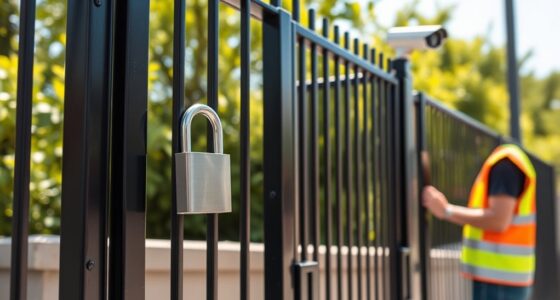After a power outage, focus on safety first by inspecting damage and revisiting manufacturer instructions for generator restart. Avoid common myths like quick fixes or automatic backup starts. Instead, prioritize careful evaluation, proper maintenance, and clear communication with your team. Taking these steps guarantees a safe and efficient recovery. If you want to learn more about essential safety tips, troubleshooting strategies, and debunking power restoration myths, you’ll find useful insights to guide your process.
Key Takeaways
- Power restoration often takes hours or days; quick fixes or assumptions can cause safety hazards.
- Proper generator maintenance and safety protocols are essential to prevent damage and ensure reliability during recovery.
- Batteries are not foolproof; handling damaged batteries carefully reduces fire and injury risks.
- Gradual power re-energizing and monitoring help maintain safety and prevent system damage.
- Clear communication and hazard assessment are critical for a safe and efficient outage recovery process.
Common Misconceptions About Power Restoration

Many people believe that power restoration happens quickly once the outage is over, but in reality, it can take hours or even days to fully restore service, depending on the extent of the damage. A common misconception is that backup generators automatically start working without maintenance, but generator maintenance is crucial to ensure safety and reliability during outages. You might think batteries are foolproof; however, battery safety is vital because damaged or improperly handled batteries can pose fire risks or cause injuries. Relying solely on quick fixes or assuming systems are ready can lead to safety hazards. Properly maintaining your generator and understanding battery safety protocols are essential steps that help guarantee a smooth and safe power restoration process. Additionally, knowing the power restoration process can help you better prepare for potential delays and troubleshooting.
Essential Steps for a Safe and Efficient Recovery

To guarantee a safe and efficient power recovery, you should start by evaluating the damage carefully and prioritizing critical systems. Check for hazards like exposed wires or leaking fuel before restoring power. Ensure generator safety by following manufacturer instructions and avoiding overloads, which can cause fires or damage. Establish clear communication protocols with team members and utility providers to coordinate efforts and share updates promptly. Confirm that all personnel know safety procedures and emergency contacts. Once the site is secure, proceed with gradually restoring power, monitoring for any irregularities. Remember, rushing can compromise safety and prolong downtime. By focusing on these essential steps—careful assessment, generator safety, and effective communication—you set the foundation for a smooth and safe recovery process. Additionally, understanding juice detox side effects can help prevent health issues during recovery periods that involve dietary adjustments.
Key Factors to Focus On for a Successful Outage Return

Focusing on key factors during an outage return guarantees a safe and effective recovery process. First, ensure your generator operates at optimal efficiency; running it properly prevents damage and guarantees reliable power. Monitor generator performance closely and perform necessary maintenance before restarting. Clear outage communication is also vital—keep all team members informed about your recovery steps, timelines, and safety protocols. This minimizes confusion and ensures everyone is aligned. Prioritize verifying that power sources are stable before re-energizing systems. Address any fuel or equipment issues promptly to avoid future outages. By concentrating on generator efficiency and maintaining open, accurate outage communication, you set the stage for a smooth, safe, and successful outage recovery. Proper generator maintenance is essential to prevent issues that could prolong downtime or cause damage.
Frequently Asked Questions
How Long Should a Typical Outage Recovery Process Take?
The outage recovery process varies, but it usually takes a few hours to several days depending on the extent of damage. You should prioritize equipment upgrades and staff training to speed up recovery. During this time, you’ll identify issues, restore essential systems, and confirm staff are prepared for future outages. A well-planned recovery minimizes downtime, so stay organized and focused on critical tasks to get back online efficiently.
What Are the Most Common Causes of Prolonged Outages?
You often experience prolonged outages due to utility redundancy issues and supply chain disruptions. When utility redundancy isn’t properly maintained, backup systems fail or are unavailable, extending outage durations. Additionally, supply chain problems delay equipment repairs or replacements, making restoration slower. To minimize these delays, guarantee your utility systems have reliable redundancy and your supply chain is resilient, enabling faster recovery and reducing outage impacts.
How Do Weather Conditions Impact Recovery Efforts?
Weather conditions are the storm clouds on your recovery horizon, directly impacting your efforts. Heavy rain, snow, or high winds can slow down repairs, cause additional damage, and hinder access to affected sites. To navigate this, you need strong climate resilience and solid emergency preparedness plans. By anticipating weather’s unpredictable nature, you make sure your team is ready to act swiftly and adapt, minimizing downtime and securing a faster return to normal.
Can Backup Systems Fully Replace Regular Power During Outages?
Backup systems can’t fully replace regular power during outages. They provide essential power replacement for critical functions, ensuring safety and minimal disruption. However, backup systems are typically limited in capacity and runtime, so you’ll need to plan for eventual power restoration from the main grid. Relying solely on backup systems isn’t practical long-term, but they’re crucial for immediate response and maintaining essential operations until regular power resumes.
What Are the Long-Term Effects of Repeated Outages on Infrastructure?
Repeated outages weaken your infrastructure resilience and jeopardize power grid stability over time. You might notice more frequent failures, increased repair costs, and diminished system reliability. These disruptions strain your resources and reduce your ability to provide consistent power. To protect your infrastructure, prioritize investments in modernization, redundancy, and maintenance. Addressing these issues now helps ensure a resilient power grid that withstands future outages and maintains long-term stability.
Conclusion
Remember, the path to a smooth recovery isn’t about rushing back to normal but gently guiding your system back to its natural rhythm. Dispelling myths and focusing on what truly matters helps you navigate this delicate process with confidence. With patience and attention to detail, you’ll restore stability and comfort, like tending a garden after a storm—carefully, thoughtfully, and with an eye toward new growth. Trust the process, and brighter days will follow.









